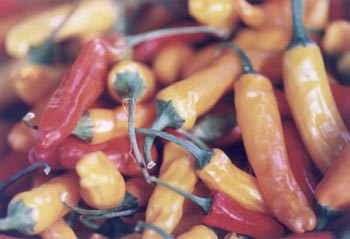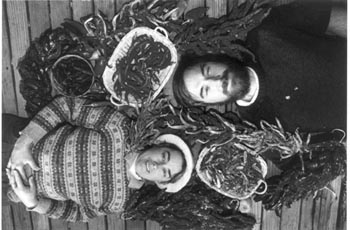![[MetroActive Dining]](/gifs/dining468.gif)
[ Dining Index | Sonoma County | MetroActive Central | Archives ]
Some like it hot: Tierra Vegetables is a little on the chili side.
Burning Desire
Tierra Vegetables champions the chipotle
By Marina Wolf
"OH, NOW LOOK at those!" says Lee James of Tierra Vegetables, reaching into the low-lying tumble of pepper plants and plucking out a reddish-purple fruit. "They look even prettier all piled up in a box," she says as she rubs off the field dust and takes a bite. "People think the field must be pretty, too, but when it's later in the season the plants fall over and the weeds come in . . ." Then she notices my stare and stops mid-stride. "I didn't even think to offer," she says and rummages again for a pepper. "Do you want one?"
I do, but I feel hesitant about biting right in the way Lee does. What she eats like apples could be incendiary devices to mortal folks. After all, Lee, with her brother Wayne James and his wife, Evie Truxaw, are the people who helped put chipotle chilis on the North American map. Tierra Vegetables' seven varieties of smoked chilis were recently dubbed an endangered American foodstuff and brought on board a metaphorical food ark by Slow Food, a global organization dedicated to good food and traditional foodways. Sure, Tierra grows regular garden stuff at three sites around the county, but Lee, Wayne, and Evie love chipotles first and foremost. Hell, even their hordes of shelties love chilis.
Lee is quick to assure me that this pepper is a sweet pimiento, but I still hesitate, rubbing the dust off as an excuse to look around. The field looks like any other well-used piece of farmland in the middle of the harvest season. Watermelon rinds from the failed melon plantings lie in little heaps at the end of the rows. Tractor ruts provide a rough track for Wayne, who walks barefoot everywhere--damp fields, gravel driveways, a chicken crossing--and now uses his calloused toes to poke at the first plant in a row of greens. "These white-top beets aren't doing so well. Since when do we get leaf miner in October?" he exclaims, glaring at the leaves that are withering up brown and dry along the edges of the pale tender leaves.
Wayne's barefootedness is just another example of Tierra's laid-back atmosphere. The buildings are weather-beaten, the flowers out front are spent in the fall heat, brown and trodden upon. The James don't have time to prettify their farm. They've got 60 people to fill produce boxes for, and they've got chilis to smoke.
"You can't grow a chipotle; it's a process," says Lee later at her house in Healdsburg. "People still can't figure that out. They're always asking for fresh chipotles. But it's a smoked, dried thing. You don't pick them like that."
Lee is leaning on a key part of the process: the homemade smoker. Over the 10 years that Lee, Wayne, and Evie have been picking their peppers, the smoker has seen several incarnations, from an old refrigerator with holes poked in it to the current model, a cement-and-brick behemoth sporting two chimneys, an automatic fan system, and shelving space for up to 400 pounds of fresh chilis at a time. It's not as picturesque, perhaps, as the traditional chipotle smoking in Oaxaca, where the peppers cure above an open fire for days. But it's definitely a step up in terms of quantity and quality control, and it gets the job done.
No bed of roses: Brother and sister team of Wayne and Lee James have established a red-hot business built on their locally grown chilis.
The beginnings of Tierra's chipotle empire are equally unromantic. I expected a tale of mysterious scents, a glimpse through a shaded southern courtyard, a sizzle on the tongue from that first memorable taste. But in fact, the whole thing started simply enough when a customer at their booth at the Marin Farmers' Market asked for chipotle peppers. Up until then, none of the Tierra folks had tasted chipotle, and Lee remembers her first encounter with the smoky chili as not very inspiring. "It was terrible," she says straight out. "It tasted like creosote. So we said, 'We could make it better than that.' "
And so they did, after years of tinkering with the factors that go into making a smoked, dried chili: heat, air, smoke, time. The formula that Tierra has settled on is deceptively simple: five days in the smokers, followed by up to two weeks in a dryer if the chili is a jalapeño or some other pepper with thick flesh or high oil content. The firebox burns dry logs of prune and other fruit woods, which give off a clean, pure-smoke smell, like a well-built campfire.
I had half-expected the air to sting with the pungent aroma of toasted chili. But these peppers are not cooked, only air dried in the smoker. "You don't want the temperature to get too hot or you're going to lose all the flavor," says Wayne after inspecting the height of the flame hovering over the one log inside. Another secret to the incomparable Tierra aroma: dried basil stems on the fire. I jerk my head up and sniff at the smoke, the aroma of which has changed from campfire to college dorm room. "That smells like . . ."
Wayne and Lee grin knowingly. "Yep," says Lee. "It smells like another green herb that you smoke."
In such a relaxed atmosphere, it's hard to get worked up about anything. But I'm still curious about something. Getting picked for the Slow Food ark is both an honor and a warning. Is it true that chipotle making is an endangered art?
"Well, there will always be chipotles," says Wayne as he closes the lid on the firebox. "There will always be commercially produced chilis."
Lee nods her head in grim agreement. "It's the process that's being lost."
[ Sonoma County | MetroActive Central | Archives ]
Copyright © Metro Publishing Inc. Maintained by Boulevards New Media.
![]()

Photograph by Michael Amsler
 Photograph by Janet Orsi
Photograph by Janet Orsi
From the November 4-10, 1999 issue of the Sonoma County Independent.